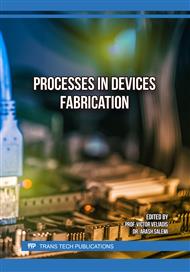[1]
F. Roccaforte, P. Fiorenza, G. Greco, R. Lo Nigro, F. Giannazzo, F. Iucolano, M. Saggio, Emerging trends in wide band gap semiconductors (SiC and GaN) technology for power devices, Microelectron. Eng. 187–188 (2018) 66-77.
DOI: 10.1016/j.mee.2017.11.021
Google Scholar
[2]
R. Yakimova, C. Hemmingsson, M.F. MacMillan, T. Yakimov, E. Janzén, Barrier Height Determination for n-Type 4H-SiC Schottky Contacts Made Using Various Metals, J. Electron. Mater. 27 (1998) 871-875.
DOI: 10.1007/s11664-998-0112-5
Google Scholar
[3]
M. Vivona, G. Bellocchi, R. Lo Nigro, S. Rascunà, F. Roccaforte, Electrical evolution of W and WC Schottky contacts on 4H-SiC at different annealing temperatures, Semicond. Sci. Technol. 37 (2022) 015012 1-8.
DOI: 10.1088/1361-6641/ac3375
Google Scholar
[4]
R. Rupp, R. Elpelt, R. Gerlach, R. Schomer, M.; Draghici, A new SiC diode with significantly reduced threshold voltage. In Proceedings of the 2017 29th International Symposium on Power Semiconductor Devices and IC's (ISPSD), Sapporo, Japan, 28 May–1 June 2017; p.355–358.
DOI: 10.23919/ispsd.2017.7988991
Google Scholar
[5]
A. B. Renz, V. A. Shah, O. J. Vavasour, Y. Bonyadi, F. Li, T. Dai, G. W. C. Baker, S. Hindmarsh, Y. Han, M. Walker, Y. Sharma, Y. Liu, B. Raghothamachar, M. Dudley, P. A. Mawby, P. M. Gammon, The improvement of Mo/4H-SiC Schottky diodes via a P2O5 surface passivation treatment, J. Appl. Phys. 127 (2020) 025704 1-9.
DOI: 10.1063/1.5133739
Google Scholar
[6]
T. N. Oder and S. B. Nardella, Effects of deposition temperature on Mo/SiC Schottky contacts, AIP Advances 12 (2022) 025117 1-6.
DOI: 10.1063/5.0083977
Google Scholar
[7]
T. Suzuki, H. Wakabayashi, K. Tsutsui, H. Iwai, K. Kakushima, Laminated Mo/C Electrodes for 4H-SiC Schottky Barrier Diodes with Ideal Interface Characteristics, IEEE Electron. Dev. Lett. 37 (2016) 618-620.
DOI: 10.1109/led.2016.2536738
Google Scholar
[8]
Z.-Y Yang, Y. Wang, X. Li, J. Yang, D. Shi, F. Cao, Thermal stability of Mo–C alloy Schottky contacts on n-type 4H-SiC, Microelectron. Eng. 239 (2021) 111531 1-5.
DOI: 10.1016/j.mee.2021.111531
Google Scholar
[9]
M Vivona, G Greco, F Giannazzo, R Lo Nigro, S Rascunà, M Saggio and F Roccaforte, Thermal stability of the current transport mechanisms in Ni-based Ohmic contacts on n- and p-implanted 4H-SiC, Semicond. Sci. Technol. 29 (2014) 075018 1-7.
DOI: 10.1088/0268-1242/29/7/075018
Google Scholar
[10]
S. M. Sze, and K. N. Kwok, Physics of Semiconductor Devices; John Wiley & Sons: Hoboken, NJ, USA, 2007.
Google Scholar
[11]
F. A. Padovani and R. Stratton, Field and thermionic-field emission in Schottky barriers. Solid-State Electron. 9 (1966) 695–707.
DOI: 10.1016/0038-1101(66)90097-9
Google Scholar


